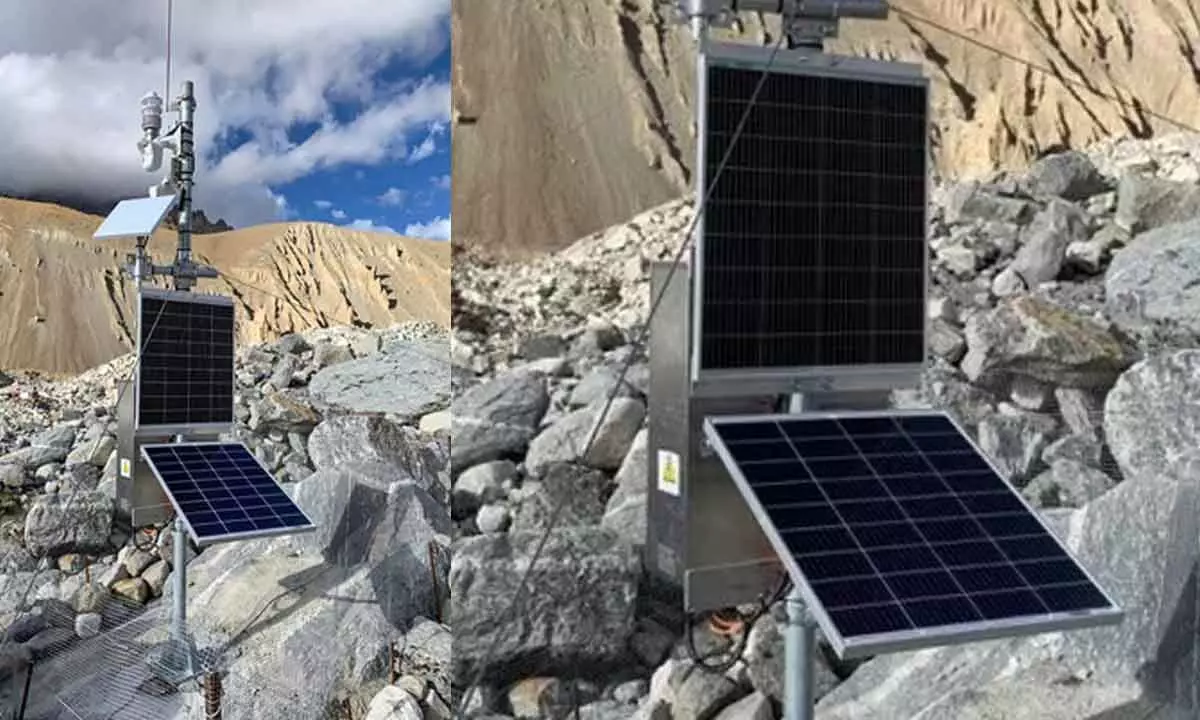Live
- M4M’ Hindi trailer launches at IFFI
- ‘RAPO22’ launches with grandeur
- Drug abuse eating into vitals of our nation
- Sai Durgha Tej gets special gift
- They always want me to win, and now I feel lucky to have been offered a story like ‘Zebra’: Satyadev Kancharana
- ‘Democracy first, humanity first’: PM Modi in Guyana's parliament on two countries' similarities
- PKL Season 11: Telugu Titans register third straight win to top standings
- Is Pollution Contributing to Your COPD?
- NASA Unveils Underwater Robots for Exploring Jupiter's Moons
- Additional Central forces arrive in violence-hit Manipur
Just In
Solar-Powered Weather Station At High-Risk Glacial Lake In Sikkim Fails Just Days After Installation


- A solar-powered automated weather station, part of a critical early warning system, stopped transmitting data merely three days after installation in a high-risk glacial lake in Sikkim.
- This unfortunate development occurred just ahead of a disastrous Glacial Lake Outburst Flood (GLOF) in the region. Learn more about the challenging conditions and the mission's significance in addressing such natural hazards.
One of the two solar-powered twin-camera automated weather stations recently installed at high-risk glacial lakes in Sikkim experienced a loss of signal transmission only three days after its installation in September. These stations were set up by two multi-agency teams led by the National Disaster Management Authority (NDMA) on September 16, just days before a Glacial Lake Outburst Flood (GLOF) caused a flash flood in northern Sikkim on October 3.
The NDMA, along with several organizations, undertook expeditions to two particularly vulnerable glacial lakes, South Lhonak and Shako Cho, situated at elevations of 15,000 to 16,000 feet. The purpose was to install two solar-powered, twin-camera automated weather stations, which could provide crucial data for monitoring weather and glacial conditions in these remote and challenging locations.
The statement issued by NDMA emphasized the immense preparations required due to the extreme conditions, rugged terrain, and unmanned station installation to ensure the safety and functionality of these weather stations.
This mission not only succeeded in identifying suitable installation sites and setting up the automated weather stations but also laid the groundwork for a comprehensive early warning system. It identified potential locations for sensor installation during a subsequent expedition and recommended mitigation measures for future operations.
Initially, the stations were performing well, sending back over 250 weather observations and camera views daily. However, the equipment at the South Lhonak site ceased transmitting data after September 19, despite a physical check on September 28 by an Indo-Tibetan Border Police (ITBP) contingent, which found the equipment to be physically stable but unresponsive. In contrast, the equipment at the Shako Cho site continued to transmit daily data.
This initiative is part of the GLOF Risk Mitigation Programme, which aims to extend its efforts to address the risks associated with high-risk glacial lakes across India.
The installation of these weather stations was a collaborative effort involving numerous organizations, including the NDMA, the Sikkim government, the Indian Army, ITBP, CWC, GSI, NCPOR, NRSC (ISRO), DGRE, CDAC, SOI, and SDC (Swiss Agency for Development and Cooperation).
Tragically, the flash flood in Sikkim resulted in 37 casualties, including 10 Army personnel, and left 78 people missing, according to the State Disaster Management Authority (SSDMA). Moreover, the flood displaced a total of 3,709 people from their homes.

© 2024 Hyderabad Media House Limited/The Hans India. All rights reserved. Powered by hocalwire.com






